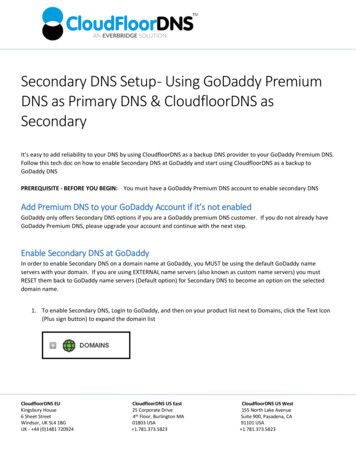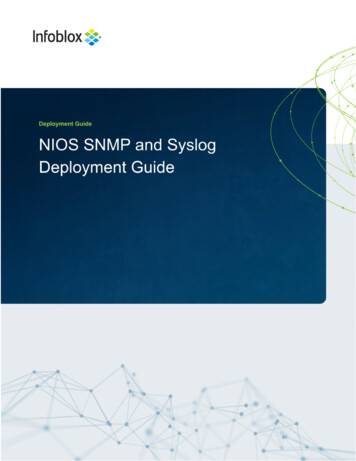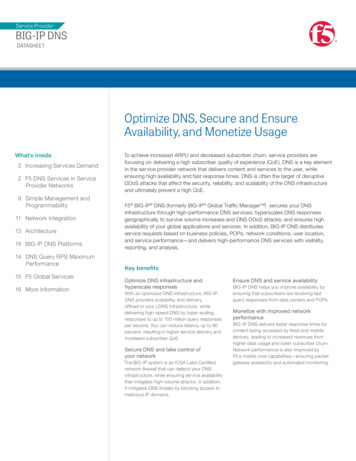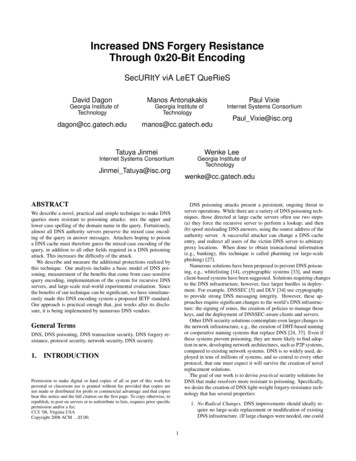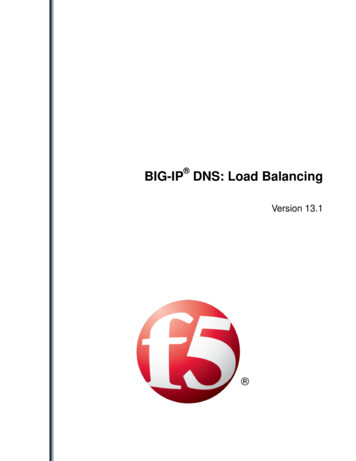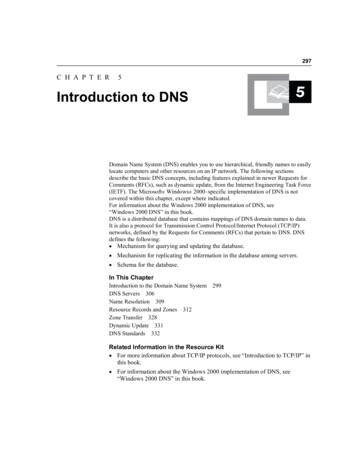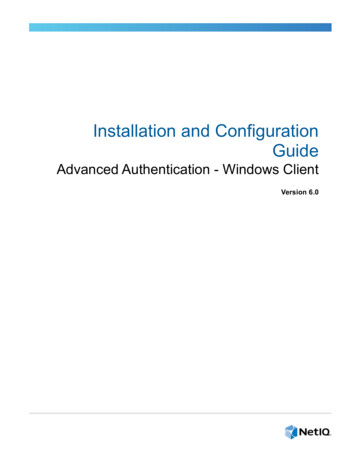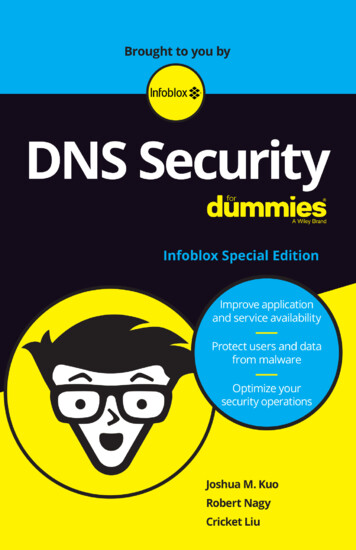
Transcription
Ch 3: DNS VulnerabilitiesUpdated 9-27-16
Causes of Vulnerabilities Configuration errorsArchitecture mistakesVulnerable software implementationsProtocol weaknessesFailure to use the security extensions inthe protocol
DNS Architecture Mistakes
Single Point of Failure The SOA could be a single server at asingle site– If the server crashes, clients would be unableto resolve any of the domains in the zone– Also Internet connection outage, powerfailure, fire, storm, etc. If a single server is the recursive resolverfor clients in an intranet– They'll all lose DNS service if it goes gown
Two Servers Many hostingproviders do notallow delegationof DNS service toa single DNSserver name End devices aretypicallyprovisioned withtwo DNS serveraddresses
Router or Link
Data Center or Single Site If all DNS servers are at a single site ordata center, a regional event could takethem all down– Earthquake– Power failure The more critical the DNS service is, themore distributed servers should be– Geographically and topologically– Like the 13 root servers
Common Configuration Errors
Exposure of Internal Information Only public Web-facing servers should bein the external DNS zone files Your DNS server is a target of attack andmay be compromised
Leakage of Internal Queriesto the Internet Some Windows DHCP clients leak dynamicDNS updates to the Internet– Link Ch 3a
Windows Versions These packets were sent from Windows2000, Windows XP, and Server 2003– When tested in 2006 To prevent this, configure local DNSservers not to refer internal machines toexternal name servers– And block DNS requests directly to theInternet
Unnecessary Recursiveness Not all name servers need to be recursive– Authoritative servers don't need to– Recursion is complex and burdens servers– Added function means more potentialvulnerabilities Recursion may be on by default– Thousands of open recursive resolvers on theInternet
Failure to Restrict Access Recursive DNS servers should only acceptqueries from your own clients– Block outside addresses with access controllists
Open Resolver Project Link Ch 3b
Testing CCSF's DNS Servers in 2016
Testing CCSF's DNS Servers All are closed as of 9-27-16
Unprotected Zone Transfers Data transfers from a master to a slaveauthoritative server– Update the zone files on the slave Can be requested by any other host Reveals information about all hosts in thezone– Information disclosure vulnerability
NorthKorea Link Ch 3i
Running Server in Privileged Mode root on Unix/Linux Administrator on Windows– Makes any security flaws more dangerous– Attacker who owns DNS then owns the server
Weakness in Software Implementations DNS servers have bugs and vulnerabilities– Buffer overflows– Other errors Search CVE List for "ISC Bind"
Severe 2008 Bind Vulnerability Attack used an IP address like– 1.2.3.4.xxxxxxxx-exploit-code-here-xxxx Another list of DNS vulns at link Ch 3d
Source Port Randomization Good video Link Ch 3e
Randomness of Transaction ID Each DNS query and response has a TXIDfield– 16 bits long (65,536 possible values)– Should be random Bind 8 & 9 used predictable transactionIDs– So only ten guesses were needed to spoof thereply
Randomness of Transaction ID
Tricking a Target into Using Your DNSServer Run a domain evil.com with a SOA youcontrol ns1.evil.com– Send the target an email with a link toserver.evil.com and hope someone clicks it– Send email from joe@evil.com to target emailaddress The server will automatically perform a reverselookup to detect spam
Tricking a Target into Making MultipleDNS Queries CNAME Chaining– www.evil.com is a CNAME for www1.evil.com– www1.evil.com is a CNAME forwww2.evil.com– www2.evil.com is a CNAME forwww3.evil.com– etc.
Tricking a Target into Making MultipleDNS Queries NS Referral Chaining and NS Chains– a.a.a.a.evil.com has SOA ns.evil.com– ns.evil.com delegates to ns.a.evil.com– ns.a.evil.com delegates to ns.a.a.evil.com– etc.
Protocol Design Weaknesses
Weak Authentication DNS uses these elements to match arequest and a response– Transaction ID (16 bits)– Question– Source and destination IP– Source and destination ports But request destination port is known (53) Client accepts the first response thatmeets these criteria, and caches the result
DNS Cache Poisoning A false response that tricks the client putsa false entry into its cache
DNS Cache PoisoningAttacker1.2.3.4Whereis www.yahoo.com?www.yahoo.com isat 1.2.3.4om?c.oohw.yawwsiWhere3.4.2.1tis amoc.oahowww.yTargetDNSResolver
Link Ch 3f
Link Ch 3g
Consequences of the Kaminsky Attack Attack can be placed in a Web page––––––Many img tags img src aaaa.paypal.com img src aaab.paypal.com img src aaac.paypal.com img src aaad.paypal.com etc. If one Comcast customer views that page, allother Comcast customers will be sent to thefake paypal.com Poisoning can take as few as 10 seconds
Man-in-the-Middle Attacks Attacker in the middle has enough info toperfectly forge responses– Unless DNSSEC is usedTargetAttackerDNS Resolver
DNS as a DoS Amplifier Small requests lead to large responses UDP allows spoofing the source IP addressTargetOpen DNS ResolverAttacker
Your DNS server is a target of attack and . If one Comcast customer views that page, all other Comcast customers will be sent to the . - Unless DNSSEC is used Target Attacker DNS Resolver. DNS as a DoS Amplifier Small requests lead to large responses UDP allows spoofing the source IP address Target Open DNS Resolver Attacker.
